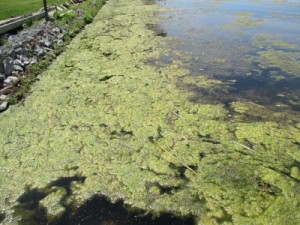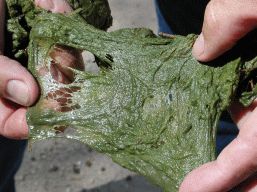Algae Problems
Does your shoreline look like this photo of algae problems taken this weekend? Shown is a type of filamentous algae mat called Cladophora, although it may contain several other types of algae as well. This type of algae is extremely common and is the result of too high nutrient levels in the lake. 
If both phosphorus and nitrogen are provided in excess at the same time, algae will grow very quickly as it has done along this shoreline near Portview Road. Algae are an an essential component of lake ecosystems because they take the energy of the sun and convert it into a form that can be used by organisms using photosynthesis. Algae are food for invertebrates and small fish, which are then fed on by larger fish and eventually by top predoators. Thus algae are a significant source of energy that supports the entire lake food web.
This type of algae is not toxic and won’t hurt you or your animals, but it is very ugly and can lead to stinking, rotting masses as it comes ashore. It does not mean that the lake is unhealthy. Without some algae, there is no life in a lake.
WHY YOU MIGHT BE GETTING AN EXCESS OF ALGAE GROWTH THIS YEAR
When you see this type of algae, you should ask yourself what could have caused such a large bloom as this one of your shore. The following are some of the reasons why there might be an excess this year and in this place.
- Winter brought a lot of snow this year. That snow not only contains high levels of atmospheric nitrogen and phosphorus deposits, but because it ran off quickly it pulled with it large amounts of surface nutrients, silt and other pollutants. That all ran into the lake from your property and your neighbours’ properties around you.

- Older, highly populated areas with small lots and septic beds that are close to the lake, or have inadequate holding tanks, contribute high amounts of nutrients. Highly populated areas also have more dogs to contribute more runoff nutrient from their excrement.
- Construction sites that have open soil and no silt curtains at the lake contribute large amounts of nutrients from that open soil as well as silt that fills in the lake. That soil probably had the remains of the old septic bed and now that nutrient laden soil is free to run off into the lake.
- Areas that slope sharply to the lake and have many driveways, rooftops, and roads will have large amounts of nutrients, silt and pollutants running directly into the lake.
- Properties that have no buffer zones of lake plants and shoreline plants and trees to catch runoff and filter it will allow more into the lake than properties with cattails, other marginal species, shrubs, or thick plants.
- Properties that fertilize their lawns contribute greatly to algae.
LIFE CYCLE OF CLADOPHORA ALGAE
Cladophora, or filamentous algae, starts as stringy wool growing on the bottom or on early plants as light green strings. Later it becomes very thick. As the season progresses, it traps oxygen and pulls off the bottom or off the plants creating large gas filled mats. As the season progresses, this light green mat will turn brown and compact, but still float on the surface because of the trapped oxygen — unless it is driven to shore.
There are other types of algae you may be seeing as well, such as spirogyra or mougeotia. These appear like green clouds around submerged plants.
There is probably little chance that Lake Scugog will experience toxic blue green algae because our lake plant population, especially Eurasian watermilfoil uses up most of the nutrients.
CLEAN-UP
Raking or cutting the plants that the algae are attached to is really the only way. Herbicides cause more of a problem because of the rotting plants create more nutrients. Aeration or bubbling devices in the nearshore area can be quite expensive and will not affect the growth or persistence of algae. They will move it away from docks but it will just move elsewhere.
